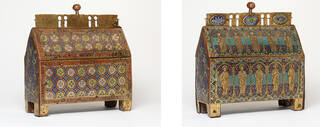Between the years 1100–1250, specialist metalworkers flourished in the areas around Cologne (Germany), Liège (Belgium) and Limoges (France). They supplied monasteries and churches with vessels essential for the rituals of the church such as chalices, crosses, candlesticks, altarpieces and shrines.
The large shrines and altarpieces were particularly complex structures – they had a wooden core overlaid with metal, and were engraved and embellished with brilliantly coloured gems or enamel plaques.
The technique of enamelling used intense heat to fuse glass onto a prepared metal surface, allowing the metalworker to create brightly coloured images. Medieval enamellers used several different techniques, but champlevé enamelling was one of the most common. The word champlevé means literally 'raised fields', referring to the way that beds were dug out of a copper plate to receive the powdered enamel.

Watch as a small plaque based on a detail from a reliquary chest made around 1180 in Limoges is recreated, following the key stages involved in producing champlevé enamel. Whilst the basic process remains the same, medieval enamellers used kilns fuelled with charcoal and relied on their judgement when firing the enamel plaques.
See how more objects were made on our YouTube channel.

